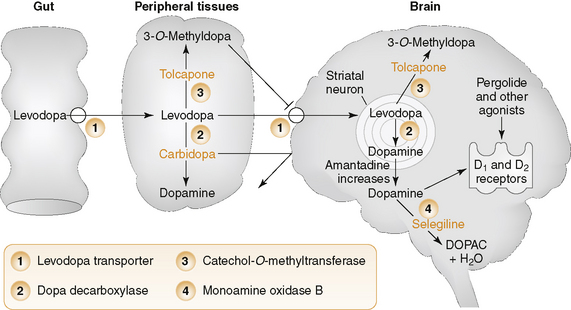Chapter 11 Drugs Used in the Treatment of Parkinson’s Disease
A. Parkinsonism is associated with lesions in the basal ganglia, especially the substantia nigra and the globus pallidus (Fig. 11-1).
B. There is a reduction in the number of cells in the substantia nigra and a decrease in the dopamine content.
C. Activation of the 4 dopaminergic pathways (Table 11-1; also see Fig. 11-1) account for many of the beneficial as well as some of the adverse effects of drugs used in treating Parkinson’s disease.
D. The lesions result in increased and improper modulation of motor activity by the extrapyramidal system, leading to a resting tremor, rigidity, and bradykinesia.
E. Therapy aims to increase the dopamine content through “replacement therapy” or reducing acetylcholine (ACh) activity, because proper function depends on the balance between the inhibitory neurotransmitter dopamine and the excitatory neurotransmitter ACh.
a. L-Dopa, the precursor to dopamine, has the ability to cross the blood-brain barrier (BBB) by facilitated diffusion.
b. Dopamine cannot be used to treat Parkinson’s disease, because this agent does not enter the brain after systemic administration.
BOX 11-1 Drugs Used To Treat Parkinson’s Disease
c. L-Dopa is rapidly metabolized, predominantly by decarboxylation (aromatic amino acid decarboxylase, AAAD) to dopamine, and excreted into the urine.
d. L-Dopa is always given in combination with carbidopa or benserazide; peripheral dopa decarboxylase inhibitors.
Stay updated, free articles. Join our Telegram channel

Full access? Get Clinical Tree





